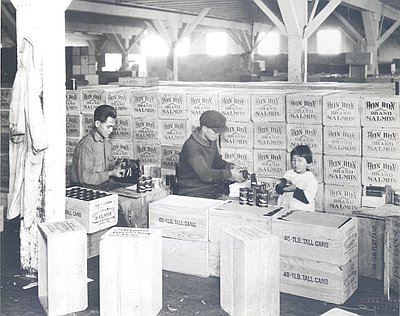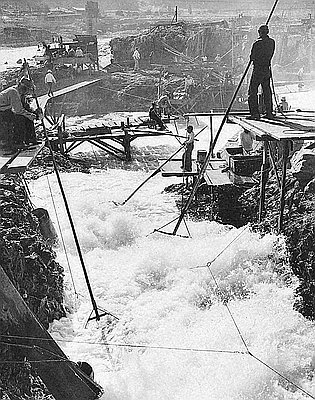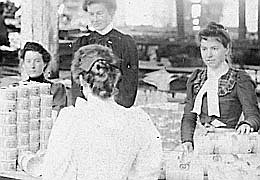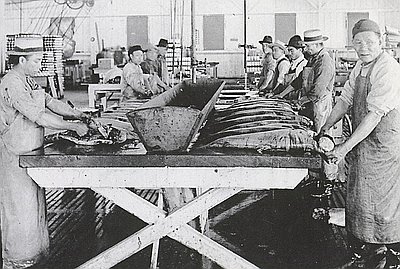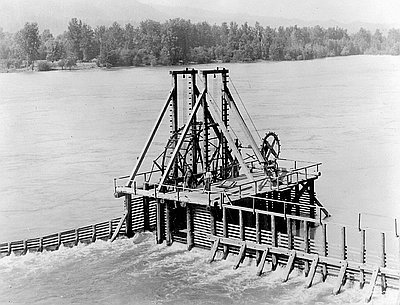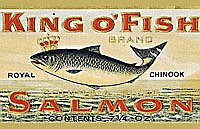The Eclipse of Canneries
The decline of salmon canneries was propelled by social and natural developments. The industry’s initial boom lasted until 1884, but then falling harvests and market saturation severely depressed prices. The next two decades were a period of consolidation, as a few companies broke or absorbed their weaker competitors. Eventually, a few consortia controlled most of the market. In 1893, the Alaska Packers Association formed a coalition in Alaska Territory, and to the south the Columbia River Packers Association was formed in 1899.
Consolidation did ease the industry’s self-destructive impulses, but it could not completely forestall other forces that were undermining the canned salmon market. From the 1860s to 1900, the fishery was confined to the lower Columbia, but eventually nearly every space in the lower river had been claimed as a quasi-private gillnet, poundnet, or seining ground. As runs declined, water became turf; and as tensions grew, independent fishers found themselves blocked from most fishing areas.
At about the same time boat technology changed. The fishery had originally been powered by sail, but by the 1890s captains began to install internal combustion engines, liberating them from dependence on the wind. Meanwhile, the Army Corps of Engineers had been working for several decades to tame the dangerous bar at the mouth of the Columbia. By 1893, the South Jetty substantially ameliorated the vicious currents that had terrified mariners for a century.
Within this social, technological, and environmental context, recently arrived Norwegians took their gasoline-powered boats across the bar and trolled for salmon in the ocean. What they found posed new problems for canneries. Ocean-caught salmon are usually not mature. Their bodies are smaller and have less fat than an adult salmon on its spawning run. These natural contingencies converged with three technological developments: improved refrigeration, flash-freezing, and better transportation.
The result opened new markets. It made little sense to can troll-caught salmon, partly because low fat content warranted a lower grade and partly because it was possible to sell these fish fresh in North American and European markets. Only the choicest specimens were used, but urban consumers were willing to pay higher prices even for Coho, the predominant species of the ocean fishery. Early successes induced more fishers to switch to gasoline-powered engines made by Clay or Palmer. The shift was slow but unmistakable. In 1914, Columbia River packers canned nearly 22 million pounds and froze not quite 700,000 pounds of salmon; by 1935, the canned pack had fallen 6 million pounds, but the frozen fish grew by another 100,000 pounds. Refrigerated trucks and trains took ever more of the harvest directly to consumers rather than to canneries.
Anglers exacerbated these trends by using a series of bills and voter initiatives to drive net fishers from Oregon’s and Washington’s rivers. By the 1950s, only gillnetters could still work the lower Columbia River. Fishers in almost every other stream and bay had been evicted to the ocean, and with them had gone both the lifeblood of the canneries and any possibility of matching harvest to individual stocks of salmon.
© Joseph E. Taylor III, 2006. Updated and revised by OHP staff, 2014.
